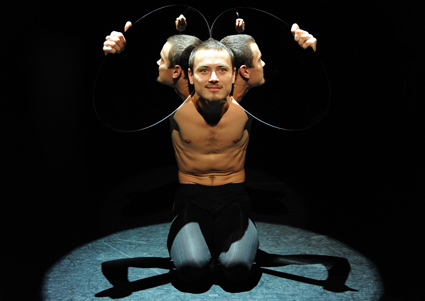 |
Paul White, In Glass photo Ian Bird, courtesy Sydney Opera House |
They mirror each other, too, sometimes in perfect synchronicity, sometimes with a calculated lag; then they split into duets with a recognisable male-female dynamic. This shifting between synchronicity and sensual dialogue evokes intriguing parallels with psychoanalytical thought, as the two dancers seem to achieve a completion of sorts in paralleling each other’s movements: through learning to imitate and respond to each other they seem to grow conscious of themselves, each other, the world, their relationship. Without going too deeply into Lacanian psychoanalysis, the notion of the mirror stage, in which reflection of one’s self allows self-conscience to emerge, is a notion dear to all performance—recurring in theories of performativity from Judith Butler among others. For a while there, the multitude of reflecting Chans and Whites exists without leader or follower: a perfect tribe of dancers, an image of primordial unity. There is some logic to this interpretation: the mirror stage is but a moment in our lives, and irretrievable—and Chan and White spend the later, larger part of In Glass out of sync, seeking each other. If the mirror starts as a vehicle for happy unison of the many, it soon turns into a visual maze, a passage through a glass, darkly.
Much of the dramaturgical responsibility in In Glass rests on Samuel James’ visual design, which adds a layer of video to the already complex reflecting images. Through the projections, the mirrors shatter, dancers’ limbs multiply into insectoid, almost abstract arabesques and a forest landscape engulfs Chan’s and White’s bodies as they slip behind glass. Chan, a comparatively small woman, repeatedly wanders off into the forest, as bare-footed and lost as that child in McCubbin’s painting. When she reappears on stage, she is prostrate, asleep, as if she had been spirited away without any agency of her own. In these moments In Glass appears to tell a story of star-crossed lovers, or even (to remain psychoanalytical) of that impossible thing we seek in everyone we fall in love with—the faint memory of our pre-conscious unity with the world. The repetition of loss, search and encounter echoes itself in slight inflections, as reclamation of lost ground, which never turns out to be quite the same.
Benjamin’s choreography reaches its apex with the introduction of two smaller, oval mirrors, which allow the dancers to multiply only some of their body parts, and merge into fabulous beasts. Paul White becomes a three-headed Narcissus (or Cerberus), licking and kissing his own reflection. The moment is exquisite: as the light from the mirrors scans through the audience, occasionally blinding us, we are brought into the same space as White, now as sublime as a psychotic monster. Kristina Chan’s transformation into a many-limbed Hindu deity is equally captivating: White stands behind her with the mirrors, multiplying her arms. Both dancers reflect and multiply in the larger mirrors behind them, forming a gigantic pastiche of human matter, not unlike an organic Rorschach blot. In these moments, what has so far been their internal quest grows larger, universal, archetypal. The performers could be gods or animals.
However, such moments of confronting strangeness are too rare. For the most part, In Glass insists on a certain mellow beauty which, however satisfying on a purely aesthetic level, keeps its tone too even, too centred, to build a genuinely satisfactory dramatic arc. The beauty of individual scenes is undeniable; the purpose or intent of the entire endeavour much harder to ascertain—video and choreography become sequential eye candy, creating the pleasant effect of dance wallpaper.
I am reminded of early 20th-century dance, its insistence on harmony and pure expression of the body, and, even more, of Gertrude Stein’s ‘landscape plays.’ All of Stein’s principles—the interest in reaching the unconscious, the continuous dramatic present, the play that one can contemplate as one would a park or a landscape, the seeming homogeneity of content which, actually, goes through subtle variations and loops—are present in In Glass. Stein eliminated the dramatic narrative on purpose, proclaiming that it always made her terribly nervous. In Glass comes with no such manifesto, but it does seem to be trying to create a landscape of its own sort. And it succeeds: even if we are not sure what it was saying, we do believe we have heard it say something.
The greatest part of the experience of any dance work is retrospective, the memory of a body at a constant vanishing point. As such, it is hard in a review that follows so closely after the event to say with certainty what this experience was. Perhaps that three-headed Narcissus will crystallise into an indelible image in a week’s time? It is too early to tell.
2011 Dance Massive: In Glass, choreographer Narelle Benjamin, dancers Kristina Chan, Paul White, composer Huey Benjamin, visual design Samuel James, costumes Tess Schofield, lighting Karen Norris, Beckett Theatre, Malthouse, Melbourne, March 15-20; www.dancemassive.com.au
RealTime issue #102 April-May 2011 pg. 17
© Jana Perkovic; for permission to reproduce apply to [email protected]








 back
back